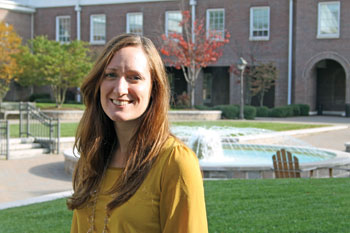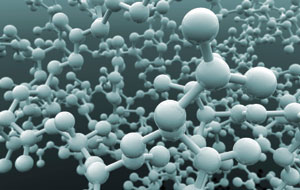Illuminating research
Professor Michelle Bunagan and her students use energy in the form of light to study protein dynamics.

Assistant Professor of Chemistry Michelle Bunagan's research is aimed at understanding “the relationships among a protein’s sequence of amino acids, the structure that the protein forms, and the steps it takes to form that structure.”

To study the fundamental dynamics of proteins—the biochemical compounds that do much of the work in cells—is to examine life at a scale so microscopic it is difficult to fathom. Some of their critical processes, observable only through the use of lasers and powerful detectors, take place within a millionth of a second.
But the precise way in which these tiny chains of amino acids coil and uncoil, form complexes with neighboring compounds, or aggregate to become larger structures is vitally important to the larger organism.
“What I do in the field of physical chemistry is fundamental research to understand the relationships among a protein’s sequence of amino acids, the structure that the protein forms, and the steps it takes to form that structure,” says Michelle Bunagan, an assistant professor of chemistry, who monitors the movements of the smallest proteins by using fluorescent amino acids as probes in a process called spectroscopy.
“Research in this field, the study of protein dynamics, is right at the intersection of biology, chemistry, and physics,” she adds.
Proteins perform essential roles in the body, such as providing structural support, transporting other molecules, and catalyzing biochemical reactions. As they do the work of the cell, they cycle back and forth between folded and unfolded structures, notes Bunagan, who describes proteins that are unfolded, or denatured, as resembling cooked spaghetti, while she says folded proteins have a well-defined compact structure. For the most part, proteins carry out their biological functions in a folded state, which allows for the proper three-dimensional placement of their amino acids for correct interaction with other proteins, cellular structures, and other compounds.
“My students and I study how these structures form, their kinetics (how quickly they form), and how changing an aspect of a protein’s environment affects the folding process,” she says, adding, “As proteins change from a denatured to a folded state, there is one step that is most costly in terms of the protein’s energy. In my graduate work at the University of Pennsylvania, we measured protein folding kinetics, and based upon those measurements, were able to describe the protein’s structure at that critical step, which is the most important one in making sure the protein folds correctly.”
Misfolding, she observes, can have catastrophic consequences: Alzheimer’s, for example, is caused by proteins that fold incorrectly, become attracted to each other, and form larger and larger aggregates in the brain known as plaque.
 “Much of the research on protein folding kinetics focuses on small proteins, which can often fold in a single step. Currently, we are interested in monitoring the kinetics associated with larger proteins that may fold via intermediate states. In these cases, there are several energetically costly steps required to reach the biologically functioning state,” she says.
“Much of the research on protein folding kinetics focuses on small proteins, which can often fold in a single step. Currently, we are interested in monitoring the kinetics associated with larger proteins that may fold via intermediate states. In these cases, there are several energetically costly steps required to reach the biologically functioning state,” she says.
In other areas of her research, Bunagan examines how different solvents affect the folding of peptides, and whether ionic liquids (salt in a liquid state) can, for example, stabilize the folded structure of the peptide. Heat can denature proteins, as when cooked egg whites lose their translucence and harden, and ionic liquids have been shown to enhance protein stability, although not much is known about how they do it.
Bunagan and her student researchers use spectroscopy—energy in the form of light—to excite proteins, and based on how a protein responds to the light, they are able to deduce information about its structure. For example, by deploying tryptophan, a fluorescent amino acid, as a probe, they can track a peptide’s structural changes.
“Based on how it emits light, we can know if a peptide has folded or unfolded,” notes David Leon ’13, who has worked with Bunagan on her experiments with ionic liquids since teaming up with her in the Mentored Undergraduate Summer Experience (MUSE) Program two summers ago.
While Bunagan’s field sheds light on the nature of some diseases, it also has important applications in the pharmaceutical industry. As an undergraduate, she helped develop a method to measure the friction that a drug molecule experiences in a hydrogel drug delivery system. Using spectroscopy, her work showed that the molecule is subjected to very different frictional forces depending on where it is in the hydrogel, which is essential to know as high friction can destroy the delivered drug.
Perhaps most important, physical chemistry provides an ever-clearer picture of organic life at its most basic level.“While the human genome has been mapped, we still don’t know what many proteins do or what their structures are,” Bunagan says. “If there were a way to predict how proteins fold based on their amino acid sequence, it could give us a guide to understand those structures and how they function in the body, to bridge the gap from sequence to structures. This predictive approach to protein characterization has been suggested as the future direction in deciphering the human genome.”
“The big breakthroughs are always derived from fundamental research,” Leon says. “We can’t know what the applications are until we’ve done basic studies.”
Posted on November 26, 2012

